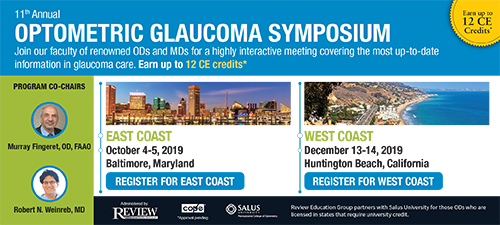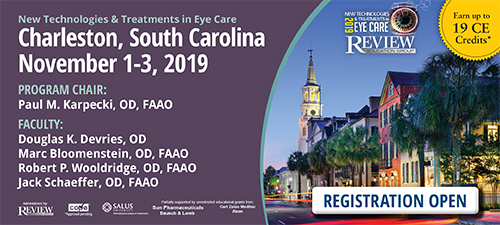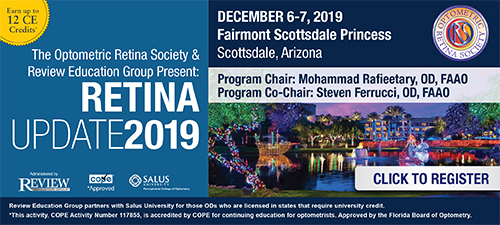
A
weekly e-journal by Art Epstein, OD, FAAO
Off the Cuff: Crossroads
This past week, Ginger Baker, the fabled drummer of the 1960s supergroup Cream, passed away at 80 years of age. With Eric Clapton on guitar, Jack Bruce on Bass and Baker on drums, Cream created a veritable wall of sound unlike anything that came before it. I will never forget the first time I heard Cream. The music was different, the times were different and after listening to them, life was different. Life is filled with crossroads. Sometimes we take the right road. Sometimes we don’t. Some choices are trivial. Some are life changing. As optometrists, I suspect we will soon find ourselves and the profession at a crossroads—an important one. Things are changing and changing fast. Much faster than most of us can grasp.
|
|||||
 |
||
| Retinal and Choroidal Vascular Changes in Eyes with Pseudoexfoliation Syndrome: a Comparative Study Using Optical Coherence Tomography Angiography | ||||
Optical coherence tomography angiography (OCTA) allows the detailed evaluation of retinal and choroidal microvascular structures with no need for a contrast agent. Pseudoexfoliation (PEX) is a condition that leads to anatomical and functional losses due to the accumulation of degraded abnormal fibrillar material in the intraocular and extraocular tissues. Histopathological studies have shown that the accumulation of PEX material in vascular structures may play a role in different pathologies such as retinal vein occlusion, iris hypoperfusion, anterior segment hypoxia, retinal arterial occlusion and neovascular glaucoma.
This study included 35 PEX eyes of 35 PEX patients—32 non-PEX fellow eyes of 32 unilateral PEX patients and 35 eyes of healthy control subjects—to evaluate and compare flow and vascular density in the retina and choroid in eyes with pseudoexfoliation (PEX), non-PEX fellow eyes and healthy eyes using optical coherence tomography angiography (OCTA). Flow area and vessel density (VD) in the superficial capillary plexus (SCP) and deep vascular plexus (DCP) were measured by OCTA as three separate parameters: total, parafoveal and foveal. Choroidal thickness (CT) and foveal avascular zone (FAZ) area were measured for each patient. There were significant differences between the PEX eyes and control eyes in total, parafoveal, and foveal flow and VD in the SCP (p<0.05 for all), while there were no significant differences between the groups in any of the flow or VD values in the DCP (p>0.05). None of the SCP and DCP flow, and VD values showed significant differences between PEX eyes and non-PEX fellow eyes, or between fellow eyes and control eyes (p>0.05). CT was significantly lower in PEX eyes compared with control eyes. FAZ area was significantly enlarged in PEX eyes compared with control eyes in both the superficial and deep layers (p<0.05). Researchers concluded that PEX eyes exhibited significant damage to the retinal and choroidal vascular structures associated with PEX material. |
||||
SOURCE: Çınar E, Yüce B, Aslan F. Retinal and choroidal vascular changes in eyes with pseudoexfoliation syndrome: a comparative study using optical coherence tomography angiography. Balkan Med J. 2019; Oct 9. [Epub ahead of print]. |
||||
 |
||
| Quantifying Choriocapillaris Flow Voids in Patients with Geographic Atrophy Using Swept-Source OCT Angiography | ||||
Researchers compared choriocapillaris (CC) flow voids (FVs) throughout the macula in patients with age-related macular degeneration (AMD) and geographic atrophy (GA) to age-similar controls using swept-source optical coherence tomography angiography (SS-OCTA). In this cross-sectional study, 12 subjects with GA secondary to nonexudative AMD and 12 age-similar controls participated. SS-OCTA was performed using a 6 mm × 6 mm scanning pattern. CC FVs were calculated using a one-standard deviation thresholding method developed from a normal database.
CC FVs were significantly increased in patients with GA compared with age-similar controls (p<.001). FVs within 2 degrees of GA were significantly increased compared with the area outside 2 degrees (p<.001). FVs beyond 2 degrees of GA were significantly increased compared with age-similar controls (p<.001). FV analysis of in vivo CC images revealed diffuse CC perfusion deficits throughout the macular region in subjects with GA secondary to nonexudative AMD. |
||||
SOURCE: Rinella NT, Zhou H, Zhang Q, et al. Quantifying choriocapillaris flow voids in patients with geographic atrophy using swept-source oct angiography. Ophthalmic Surg Lasers Imaging Retina. 2019;50(9):e229-35. |
||||
 |
||
| Topical Review: Effects of Contact Lens Wear on Corneal, Conjunctival and Lid Margin Sensitivity | ||||
The authors wrote that contemporary soft contact lenses do not affect mechanical sensitivity of the cornea, whereas conjunctival sensitivity is increased compared with non-wearers. They added that orthokeratology lens wear, however, reduces corneal sensitivity. The effects of contact lenses on lid margin sensitivity are unclear, and the link between ocular surface sensitivity and discomfort requires further exploration, according to the authors. Although up to 50% of contact lens wearers experience discomfort with varying severity, impact and frequency, the relationship between ocular surface sensitivity and ocular surface discomfort experienced during contact lens wear is unclear, the authors added. The purpose of this review was to examine and summarize the current evidence for the impact of historical and contemporary contact lens wear on ocular surface sensitivity, the etiology of changes in ocular surface sensitivity, contact lens wear-related factors associated with changes in ocular surface sensitivity, and the relationship between sensitivity and discomfort. Despite minimal effects on mechanical corneal sensitivity with contemporary soft contact lens wear, orthokeratology reduces corneal sensitivity through pressure-related effects, the authors wrote. Their review addressed the relevance of conjunctival and potential lid margin sensitivity in tolerance and discomfort with contemporary lens wear and the impact of instrument and stimulus characteristics. Less invasive techniques particularly for lid margin sensitivity measurements are required, the authors suggested. Given the potential interactions between a contact lens and the varied types of ocular surface nociceptors, instruments that allow for exploration of cold and chemical sensitivity particularly may better allow the effects of lens wear to be elucidated compared with those that explore high-threshold mechanical sensitivity alone. The authors concluded that a better understanding of the relationships between lens wear and ocular surface sensitivity may result in improved management of contact lens discomfort. |
||||
SOURCE: Stapleton F, Chao C, Golebiowski B. Topical review: effects of contact lens wear on corneal, conjunctival, and lid margin sensitivity. Optom Vis Sci. 2019;96(10):790-801. |
||||
 |
||
| News & Notes | |||||||||||||||
| Allergan Expands Portfolio with Refresh Relieva Lubricant Line Allergan announced the launch of three over-the-counter products: Refresh Relieva, Refresh Relieva PF (preservative-free) multidose and Refresh Relieva For Contacts. The new line of artificial tear formulations—available in preserved, preservative-free multidose formulations and a formula for contact lens wearers—is designed to relieve discomfort due to eye dryness and to prevent further irritation. Refresh’s expanded portfolio offers a family of products with carboxymethylcellulose (CMC), hyaluronic acid (HA, an inactive ingredient), glycerin and HydroCell technology—Allergan's proprietary sodium chloride (NaCl)-free, glycerin-based solution designed to hydrate and maintain the volume of cells on the ocular surface. Read more. |
|||||||||||||||
| CATS Tonometer Prism Now Available The CATS Tonometer Reusable Prism is now available for order through a variety of key distributors in the United States. The FDA-cleared tonometer prism was created to set a new standard in reliable Goldmann IOP measurement. The patented applanation surface of the prism is designed to seamlessly integrate into a clinician’s practice at no additional cost and requiring no new training, with the goal of streamlining patient care. It will be introduced at AAO 2019. Learn more. |
|||||||||||||||
| J&J Vision Launches Worldwide #ConnectedBySight Campaign In honor of World Sight Day on Oct. 10, Johnson & Johnson Vision launched a worldwide campaign to share the untold stories of eye care professionals, patients and organizations who are inspiring the elevation of eye health as a global priority. On Oct. 7, the company launched Worldwide #ConnectedBySight Campaign. Through its ongoing support of Lions Clubs International Foundation's Sight for Kids and Himalayan Cataract Project, Johnson & Johnson Vision has committed to provide 100,000 children with access to vision screenings and 1,000 sight-restoring surgeries to cataract patients. Read more. |
|||||||||||||||
|
|||||||||||||||
|
|||||||||||||||
|
|||||||||||||||
|
Optometric Physician™ (OP) newsletter is owned and published by Dr. Arthur Epstein. It is distributed by the Review Group, a Division of Jobson Medical Information LLC (JMI), 11 Campus Boulevard, Newtown Square, PA 19073. HOW TO ADVERTISE |





